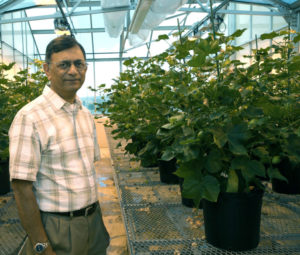FDA Approves Texas A&M’s Ultra-Low Gossypol Cotton for Human and Animal Consumption
go.ncsu.edu/readext?630779
en Español / em Português
El inglés es el idioma de control de esta página. En la medida en que haya algún conflicto entre la traducción al inglés y la traducción, el inglés prevalece.
Al hacer clic en el enlace de traducción se activa un servicio de traducción gratuito para convertir la página al español. Al igual que con cualquier traducción por Internet, la conversión no es sensible al contexto y puede que no traduzca el texto en su significado original. NC State Extension no garantiza la exactitud del texto traducido. Por favor, tenga en cuenta que algunas aplicaciones y/o servicios pueden no funcionar como se espera cuando se traducen.
Português
Inglês é o idioma de controle desta página. Na medida que haja algum conflito entre o texto original em Inglês e a tradução, o Inglês prevalece.
Ao clicar no link de tradução, um serviço gratuito de tradução será ativado para converter a página para o Português. Como em qualquer tradução pela internet, a conversão não é sensivel ao contexto e pode não ocorrer a tradução para o significado orginal. O serviço de Extensão da Carolina do Norte (NC State Extension) não garante a exatidão do texto traduzido. Por favor, observe que algumas funções ou serviços podem não funcionar como esperado após a tradução.
English
English is the controlling language of this page. To the extent there is any conflict between the English text and the translation, English controls.
Clicking on the translation link activates a free translation service to convert the page to Spanish. As with any Internet translation, the conversion is not context-sensitive and may not translate the text to its original meaning. NC State Extension does not guarantee the accuracy of the translated text. Please note that some applications and/or services may not function as expected when translated.
Collapse ▲Most people do not realize that cotton producers produce about 1.5 times as much seed as fiber or lint. Cottonseed is high in oil and protein. About 44 million metric tons of cottonseed with high protein levels are produced worldwide, but gossypol, a toxic substance in cotton plants, limits how cottonseed can be utilized. Ruminants can ingest a limited amount of cottonseed, but simple stomached animals cannot. Plant breeders were able to develop cotton varieties low in gossypol, but the varieties were never commercialized because reduced gossypol levels in the leaves allowed too much insect damage.
Using biotechnology, researchers at Texas A&M working on a project with Cotton Incorporated were able to maintain high levels of gossypol in the plant for insect protection while gossypol in the cottonseed reduced to safe levels for simple stomached animals. This makes cottonseed available as an energy and protein source for poultry, fish and humans and would be of particular value in developing countries where increased dietary protein is most needed. This ultra-low gossypol cotton was approved in the United States, first by USDA APHIS, and was recently approved for human consumption and feed use in aquaculture and poultry by FDA.
Cotton is certainly not unique in the fact that it produces chemicals to deter pests. The technology used to create ultra-low gossypol in cotton could be used in other plants as well.
Featured image: Dr. Keerti Rathore in his lab with the new ultra-low gossypol cotton plants. Photo Source: Texas A&M AgriLife photo by Beth Luedeker



